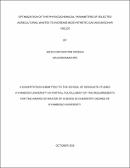Optimization of the physicochemical parameters of selected agricultural wastes to increase biosynthetic gas and biochar yields
Abstract
Biosynthetic gas and biochar are gaseous and solid fuels, respectively, that can be produced from various lignocellulosic feedstock via pyrolysis and are recognized as clean and attractive sources of renewable energy. They can be easily transported and used directly in boilers and modified turbines or upgraded for chemical production.
In this work, physicochemical characterization; moisture, ash, volatile matter, total solids, hemicellulose, lignin and cellulose contents were gravimetrically determined and subsequent pyrolysis of agricultural wastes namely; groundnut shells, coffee and rice husks to produce biosynthetic gas and biochar were conducted. The parameters; moisture, particle size and cellulose, that were used to improve the biosynthetic gas and biochar yields were optimized using Design-Expert® software Stat-Ease version 7.0.0 USA. Response Surface Methodology and Box-Behnken design were applied.
Results showed that rice husks had the highest amount of ash and total solids content at averages of 22.94 ± 0.75% w/w and 89.54 ± 0.18% w/w, respectively. Coffee husks had the least amount of ash with an average of 1.58% w/w, and total solids at 87.69 ± 0.51% w/w but with the highest amount of cellulose; 40.45 ± 1.58 % w/w, followed by groundnut shells at an average of 28.28 ± 4.45% w/w, and finally rice husk had the least amount of cellulose in the magnitude of 20.81 ± 3.61% w/w. Moisture content was essentially similar across all the biomass samples analyzed at averages of 10.46 ± 0.18% w/w, 12.31 ± 0.51% w/w and 12.49 ± 0.70% w/w for rice and coffee husks, and groundnut shells, respectively.
Basing on the overall interactive effect of particle size, moisture and cellulose content to maximize yields of biochar and biosynthetic gas, the most optimal interaction that yielded the highest quantity of biochar (1.54 g) was found to be at levels of 0.36 mm, 10.3% and 25.45% for particle size, moisture and cellulose content, respectively, whereas the most optimal interaction that yielded the highest quantity of biosynthetic gas (40.10 cm3) was found to be at 2.86 mm, 0% and 32.52% for particle size, moisture and cellulose content, respectively. In both interactions, cellulose levels corresponded to groundnut shells as the best biomass material for producing biochar and biosynthetic gas. The study recommends the use of groundnut shells for pyrolysis to produce high yields of both biochar and biosynthetic gas.

